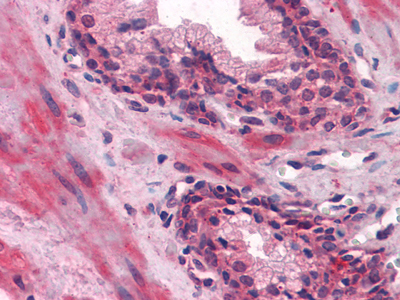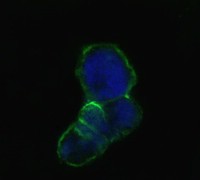Lipocalin-1 Monoclonal Antibody
- Catalog No.:YM0417
- Applications:WB;IHC;IF;ELISA
- Reactivity:Human
- Target:
- Lipocalin-1
- Gene Name:
- LCN1
- Protein Name:
- Lipocalin-1
- Human Gene Id:
- 3933
- Human Swiss Prot No:
- P31025
- Immunogen:
- Purified recombinant fragment of Lipocalin-1 expressed in E. Coli.
- Specificity:
- Lipocalin-1 Monoclonal Antibody detects endogenous levels of Lipocalin-1 protein.
- Formulation:
- Liquid in PBS containing 50% glycerol, 0.5% BSA and 0.02% sodium azide.
- Source:
- Monoclonal, Mouse
- Dilution:
- WB 1:500 - 1:2000. IHC 1:200 - 1:1000. IF 1:200 - 1:1000. ELISA: 1:10000. Not yet tested in other applications.
- Purification:
- Affinity purification
- Storage Stability:
- -15°C to -25°C/1 year(Do not lower than -25°C)
- Other Name:
- LCN1;VEGP;Lipocalin-1;Tear lipocalin;Tlc;Tear prealbumin;TP;Von Ebner gland protein;VEG protein
- Molecular Weight(Da):
- 19kD
- References:
- 1. Adv Exp Med Biol. 2002;506(Pt A):555-65.
2. J Autoimmun. 2005 Nov;25(3):229-34.
- Background:
- This gene encodes a member of the lipocalin family of small secretory proteins. Lipocalins are extracellular transport proteins that bind to a variety of hydrophobic ligands. The encoded protein is the primary lipid binding protein in tears and is overproduced in response to multiple stimuli including infection and stress. The encoded protein may be a marker for chromosome aneuploidy as well as an autoantigen in Sjogren's syndrome. Alternatively spliced transcript variants encoding multiple isoforms have been observed for this gene, and two pseudogenes of this gene are also located on the long arm of chromosome 9. [provided by RefSeq, Nov 2011],
- Function:
- caution:Could be the product of a pseudogene.,function:Could play a role in taste reception. Could be necessary for the concentration and delivery of sapid molecules in the gustatory system. Can bind various ligands, with chemical structures ranging from lipids and retinoids to the macrocyclic antibiotic rifampicin and even to microbial siderophores. Exhibits an extremely wide ligand pocket.,function:May bind a variety of ligands including lipids.,similarity:Belongs to the calycin superfamily. Lipocalin family.,subunit:Homodimer (By similarity). Binds to LMBR1L which may mediate its endocytosis.,tissue specificity:Mainly expressed in lachrymal and salivary glands. Also expressed in the prostate.,
- Subcellular Location:
- Secreted.
- Expression:
- Mainly expressed in lachrymal and salivary glands. Also expressed in the prostate.
- June 19-2018
- WESTERN IMMUNOBLOTTING PROTOCOL
- June 19-2018
- IMMUNOHISTOCHEMISTRY-PARAFFIN PROTOCOL
- June 19-2018
- IMMUNOFLUORESCENCE PROTOCOL
- September 08-2020
- FLOW-CYTOMEYRT-PROTOCOL
- May 20-2022
- Cell-Based ELISA│解您多样本WB检测之困扰
- July 13-2018
- CELL-BASED-ELISA-PROTOCOL-FOR-ACETYL-PROTEIN
- July 13-2018
- CELL-BASED-ELISA-PROTOCOL-FOR-PHOSPHO-PROTEIN
- July 13-2018
- Antibody-FAQs
- Products Images

- Western Blot analysis using Lipocalin-1 Monoclonal Antibody against HEK293 (1) and LCN1-hIgGFc transfected HEK293 cell lysate (2).

- Immunohistochemistry analysis of paraffin-embedded human Prostate tissues with AEC staining using Lipocalin-1 Monoclonal Antibody.

- Confocal immunofluorescence analysis of methanol-fixed HEK293 cells trasfected with LCN1-hIgGFc using Lipocalin-1 Monoclonal Antibody (green), showing membrane localization. Blue: DRAQ5 fluorescent DNA dye.



